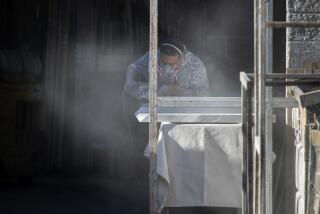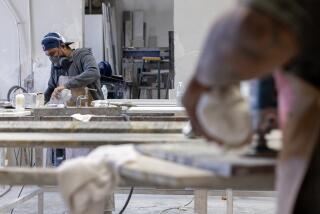Hazards Found in Nearly 75% of Garment Shops
- Share via
Nearly three-quarters of garment-sewing shops were discovered to have serious workplace health or safety problems in the first government assessment of such hazards in Southern California’s vast apparel manufacturing industry.
The problems, detailed in a study by state and federal regulators to be released today, included blocked exits, exposed electrical parts that could start a fire or cause an electrocution, and a lack of safety guards on sewing and cutting equipment to prevent, among other things, workers from having their fingers cut off.
In every case, the hazards were judged serious enough that an accident could lead to a “substantial probability of death or serious physical harm.”
Although the findings were based on a relatively small, random survey of 76 sewing contractors, officials regarded the results as a reliable reflection of the apparel industry’s serious safety problems. By comparison, authorities said, the percentage of firms in other California industries with serious safety hazards is well below 50%.
“We’ve been devoting a lot of resources to this industry for the last two or three years, and to see those kinds of numbers, it’s distressing,” said Mark A. Carleson, deputy chief of the California Division of Occupational Safety and Health, or Cal/OSHA. The agency conducted the survey with the California labor commissioner’s office and the U.S. Department of Labor.
At the same time, the new figures suggest that stepped-up labor enforcement efforts and self-regulatory programs have begun to reduce the industry’s minimum wage and overtime pay violations.
While no previous statistics were available that zeroed in on serious safety problems, authorities could gauge their progress in curbing the other widespread workplace abuses in apparel factories against what was found in a similar survey two years ago.
For instance, 61% of the 54 Southern California firms checked two years ago violated the minimum wage law, but the percentage dropped to 43% this time. Likewise, the rate of overtime pay violations dropped from 78% in 1994 to 55% this year.
Federal labor officials declared that their campaign to coax clothing manufacturers to police the labor practices of their sewing contractors--where the industry’s worst abuses tend to occur--is paying off. That campaign, along with a doubling in the number of government inspections of apparel contractors, was inspired in part by the discovery of more than 70 Thai nationals working in slavery-like conditions in El Monte last year.
The government’s promotion of “monitoring” by the manufacturers has been intended to expand enforcement beyond what can be accomplished by the thin ranks of federal and state inspectors. One key finding: Among monitored contractors, 27% were cited for overtime violations, compared to 64% of the shops that were not policed by their manufacturers.
“Beyond a shadow of a doubt, this industry has rampant violations,” said Maria Echaveste, who heads the wage and hour division of the U.S. Labor Department. “It’s not just a random few” contractors and manufacturers, she said, that are responsible for the problems.
But Echaveste, citing the lower violations among contractors supervised under monitoring programs, called the improvement in wage violations “a step in the right direction, and that’s significant.”
State labor officials, on the other hand, emphasized the need for more government inspectors to curb the industry’s workplace abuses. “You have to realize that these problems have been building up for a number of years. . . . It’s going to take a tremendous amount of effort on all of our parts to turn that around,” said Jose Millan, the state’s assistant labor commissioner.
Union activists were more skeptical, noting that the large number of “underground” contractors that pay no taxes were not represented in the survey.
“The violations would be much higher if you look at shops that operate in the underground economy,” said Steve Nutter, West Coast director of the Union of Needletrades, Industrial and Textile Employees, or UNITE.
“You have to keep in mind that this whole survey understates the level of violations. The underground operators, about 20% of the entire local industry, are the worst operators. To a degree it’s an outlaw industry.”
While Nutter acknowledged that the industry-based and self-regulatory monitoring programs are bringing some improvements, he said contractors also “are becoming more sophisticated about hiding violations.”
However, a group representing manufacturers--the Los Angeles-based California Fashion Assn.--said the inspection report is solid evidence of improving minimum wage and overtime pay compliance.
“I think we are doing an outstanding job,” said Ilse Metchek, executive director of the trade group. “Compared to other parts of the country, we are making the greatest progress in the shortest amount of time.”
Only about 30% of the 770 clothing manufacturers in Southern California--mostly larger companies--have monitoring programs, Metchek said. If that self-enforcement expands to more manufacturers and more of the region’s estimated 4,000 to 5,000 contractors, she said, the violations will be sharply reduced.
State officials are continuing to evaluate the safety figures and did not have a company-by-company breakdown of the types of serious violations uncovered in the inspections. The tally, however, showed that among the 76 sewing contractors surveyed this spring, 55 had one or more serious safety violations.
In addition to the exit, fire and electrical problems, there also were numerous instances of tagging guns being used improperly. The guns, which attach clothing tags with the use of hollow needles, are considered a threat to spread such diseases as AIDS and hepatitis.
Officials noted, however, that the existence of serious safety hazards does not necessarily translate into serious accidents. For instance, state officials said there were no known workplace deaths in Southern California’s apparel industry last year.
The one area in which violations rose over the last two years involved the percentage of firms that were not registered with the state, which increased from 11% to 33%. State officials, however, attributed that to a new, tougher policy that requires contractors to be paid up on their back taxes before they can reregister.
The 76 sewing shops inspected this spring as part of the survey were drawn from the nearly 5,000 apparel contractors in five Southern California counties that filed tax reports with the state last year.
(BEGIN TEXT OF INFOBOX / INFOGRAPHIC)
Monitoring the Garment Industry
Federal and state regulators recently inspected 76 garment industry contractors for possible labor law and safety violations. Here are the percentages of firms found in violation in 1996, compared to a similar random survey of 54 contractors in 1994:
*--*
CATEGORY 1994 1996 *All health/safety violations 98% 96% *Serious health/safety violations N.A. 72% *Failure to pay overtime 78% 55% *Failure to pay minimum wage 61% 43% *Failure to register with the state 11% 33% *Child labor violations 4% 0%
*--*
Sources: U.S. Labor Department and California Department of Industrial Relations
More to Read
Inside the business of entertainment
The Wide Shot brings you news, analysis and insights on everything from streaming wars to production — and what it all means for the future.
You may occasionally receive promotional content from the Los Angeles Times.










